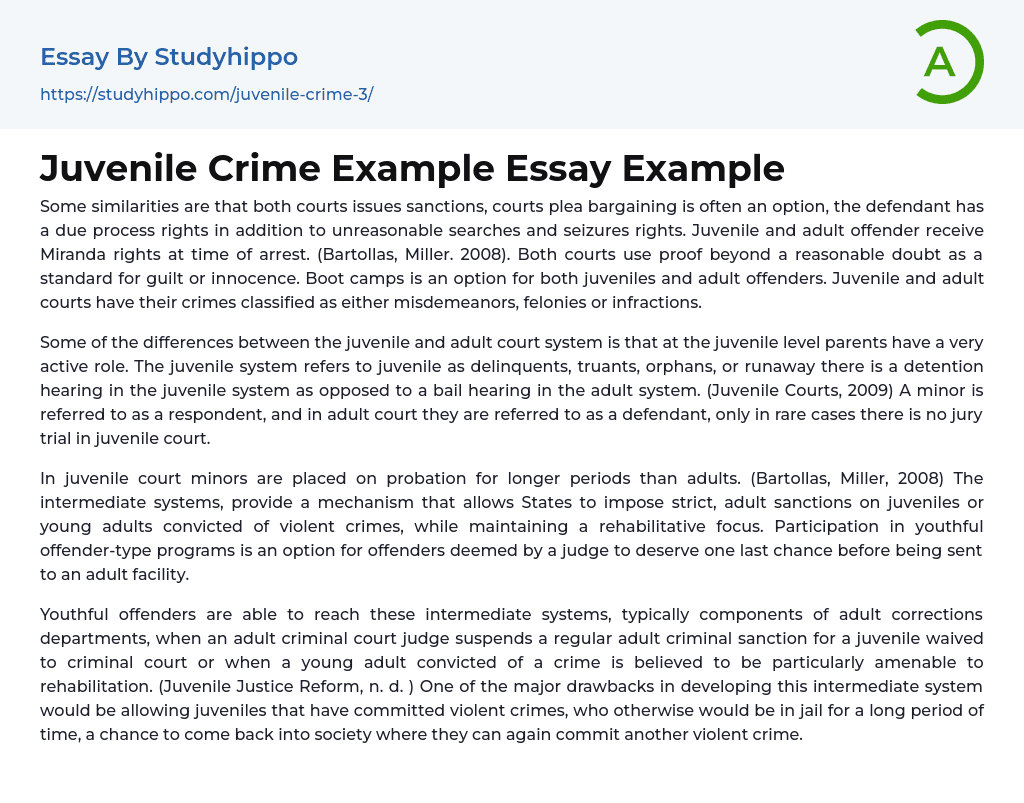Both juvenile and adult courts have similarities in terms of sanctioning individuals and offering plea bargaining options. Additionally, they ensure that defendants in both courts are granted due process rights and protection against unreasonable searches and seizures. Upon arrest, both juveniles and adult offenders are made aware of their Miranda rights. The standard for determining guilt or innocence is identical in both courts, requiring proof beyond a reasonable doubt. Furthermore, boot camps serve as an alternative rehabilitation option for both juveniles and adult offenders. Additionally, crimes in both juvenile and adult courts fall into categories such as misdemeanors, felonies, or infractions (Bartollas, Miller. 2008).
One distinction between the juvenile and adult court system is the active involvement of parents at the juvenile level. In the juvenile system, individuals are referred to as delinquents, truants,
...orphans, or runaways, and there is a detention hearing instead of a bail hearing. A minor is known as a respondent in the juvenile court, while in adult court they are called a defendant. Additionally, jury trials in juvenile court are rare. (Juvenile Courts, 2009)
Juvenile court frequently imposes lengthier probation periods on young offenders than adults (Bartollas, Miller, 2008). Intermediate systems allow States to impose strict penalties on juveniles or young adults found guilty of violent crimes while still emphasizing rehabilitation. A possible option for these offenders is to engage in youthful offender programs, offering them a chance at reform before being relocated to an adult facility.
The intermediate systems, which are part of adult corrections departments, can be accessed by youthful offenders in certain circumstances. These circumstances include when a regular adult criminal sanction is suspended by a
adult criminal court judge for a juvenile waived to criminal court or when a young adult convicted of a crime is believed to be receptive to rehabilitation. However, a major drawback of establishing this intermediate system is that it potentially gives violent juvenile offenders, who would otherwise be imprisoned for a significant duration, the opportunity to reintegrate into society where they may commit another violent crime again.
- Criminal Justice System essays
- Animal Cruelty essays
- Charles Manson essays
- Crime Prevention essays
- Crime scene essays
- Criminal Justice essays
- Criminology essays
- Cyber Crime essays
- Damages essays
- Detention essays
- Distracted Driving essays
- Drug Trafficking essays
- Drunk Driving essays
- Forensic Science essays
- Gang essays
- Hate Crime essays
- Homicide essays
- Identity Theft essays
- Juvenile Crime essays
- Juvenile Delinquency essays
- Juvenile Justice System essays
- Law Enforcement essays
- Murder essays
- Organized Crime essays
- Penology essays
- Piracy essays
- Prison essays
- Property Crime essays
- Prostitution essays
- Punishment essays
- Punishments essays
- Rape essays
- Robbery essays
- Serial Killer essays
- Sexual Assault essays
- Sexual Assault on College Campuses essays
- Sexual Harassment essays
- Sexual Offence essays
- Stealing essays
- Surveillance essays
- Ted Bundy essays
- Victim essays
- Violent crime essays
- White Collar Crime essays




